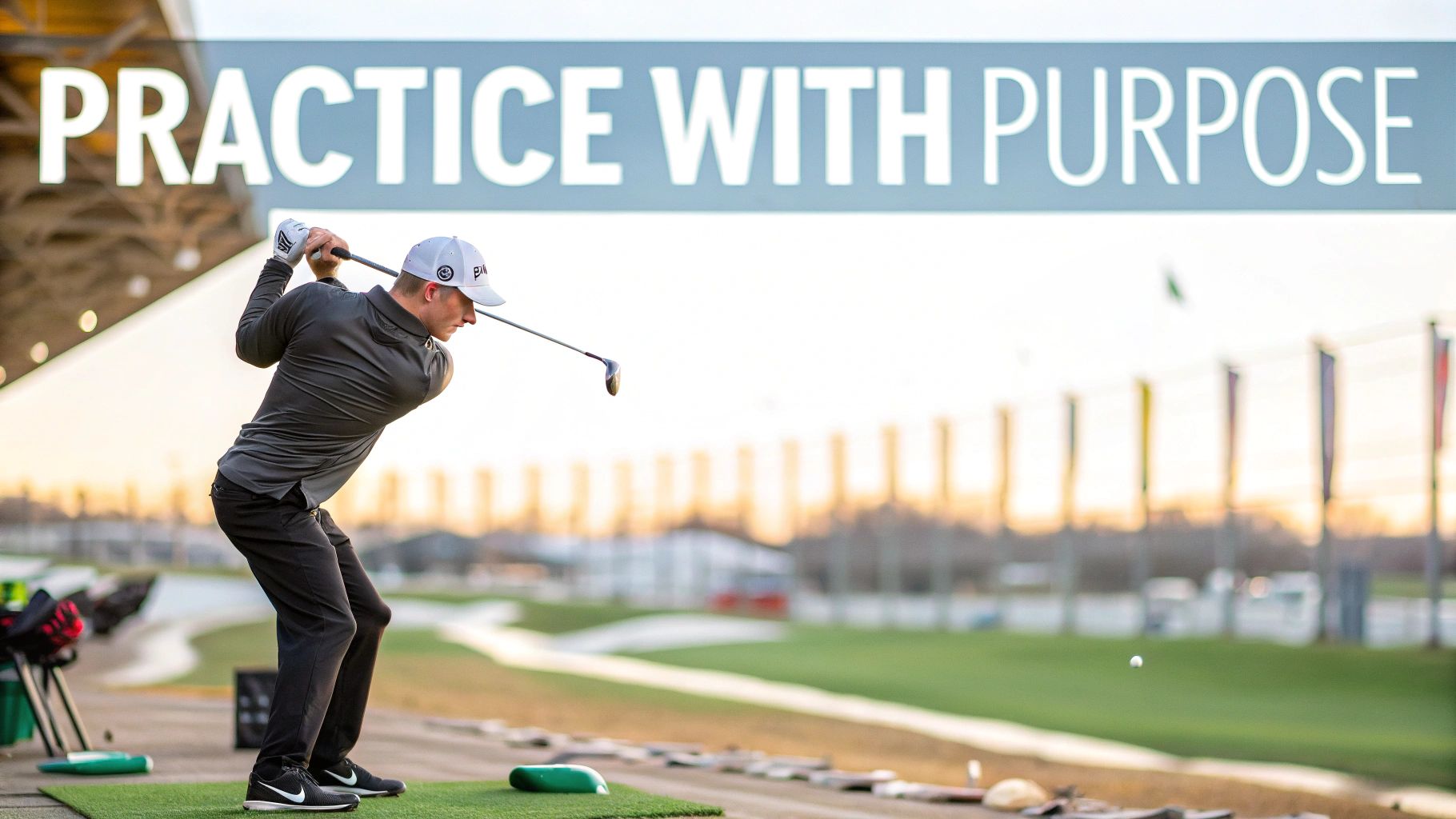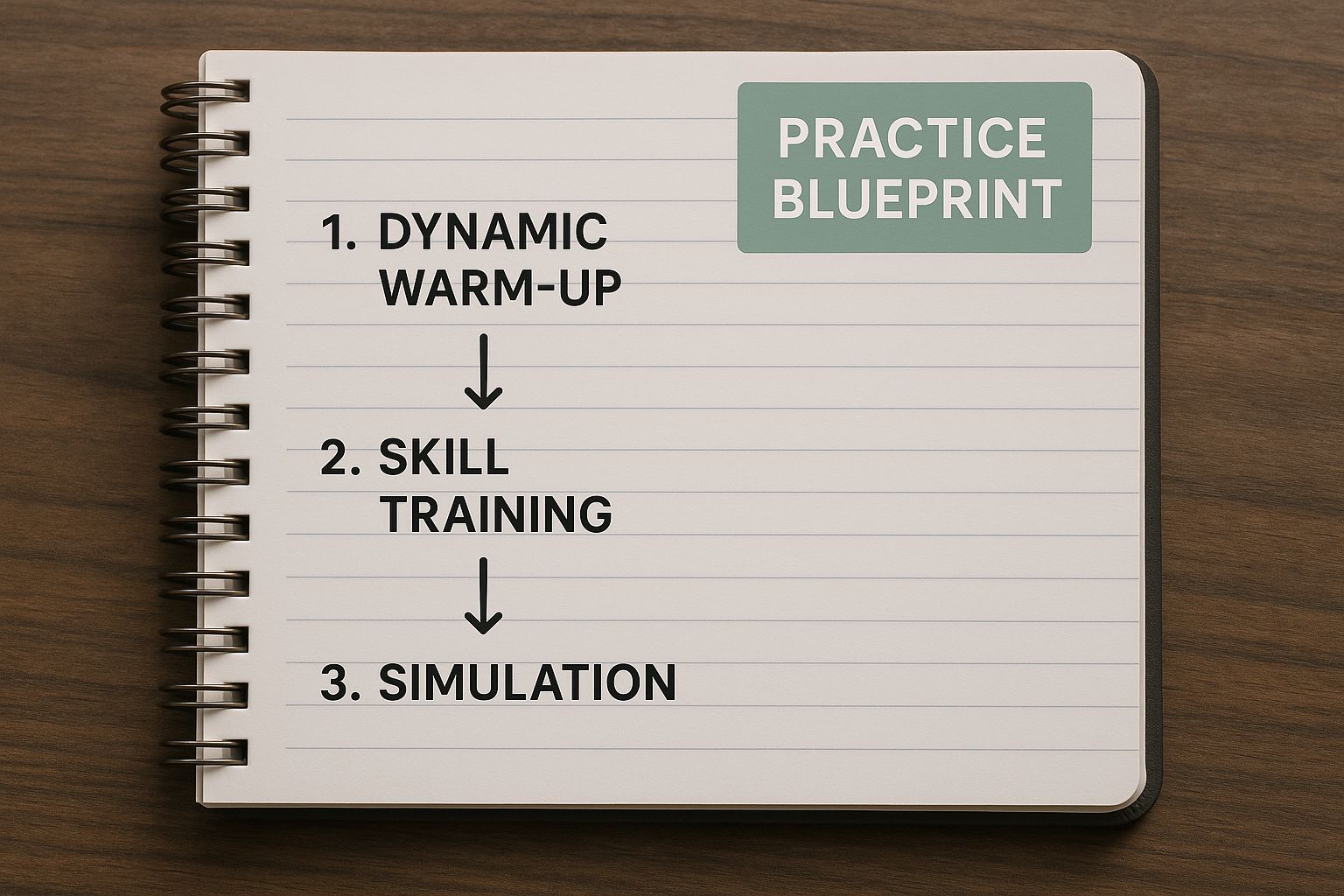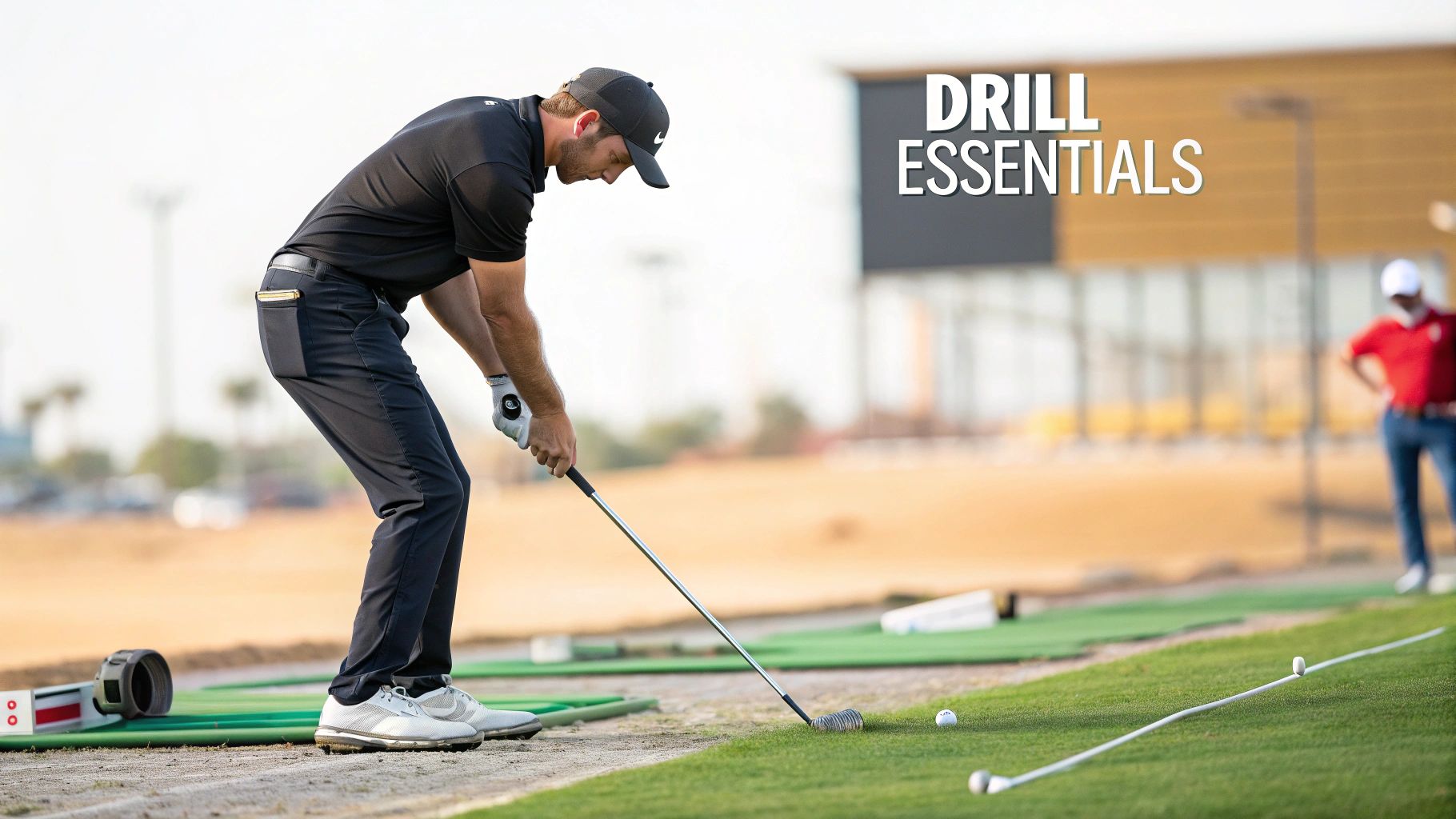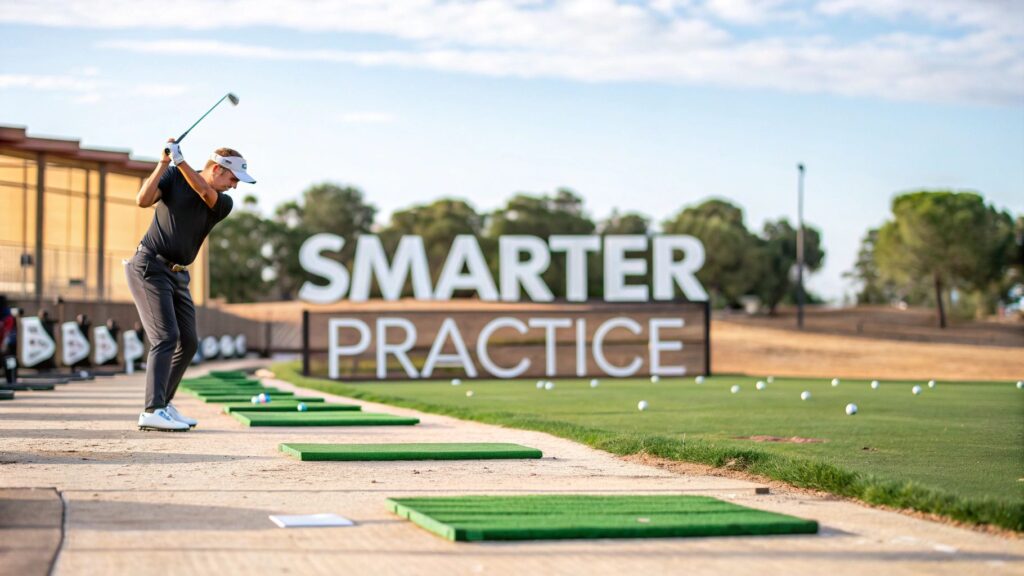Let's be real for a second. If you want to get better at golf, you have to practice. But how you practice is what separates the players who actually improve from those who just get really good at hitting the same bad shots over and over again. Effective golf practice isn't about mindlessly whacking a jumbo bucket of balls into the distance. It’s about having a plan for every single shot and focusing on quality over quantity.
This is your guide to making every trip to the range a productive one—a session that builds real consistency and actually helps you shoot lower scores on the course.
Stop Mindlessly Hitting Balls and Start Practicing with Purpose

We've all been there. You get a bucket of balls, grab your driver, aim vaguely toward the back fence, and start swinging for the fences. It might feel like you're getting some good work in, but this "grip it and rip it" approach almost never leads to lasting improvement. Why? Because it ignores a fundamental truth: golf isn't played by hitting the same shot over and over from a perfect lie.
Practicing with purpose means shifting your mindset. The range isn't just a place to warm up; it's a training ground. It's where you isolate your weaknesses, build new skills, and simulate the pressures of the course. Every ball you hit needs to have a clear intention behind it.
The Problem with Quantity Over Quality
Grinding through a large bucket of balls can actually do more harm than good. When you swing without a specific target, a pre-shot routine, or a clear goal, you’re often just reinforcing bad habits. Sure, your muscles are remembering the motion, but they're not learning how to execute a shot under pressure with a real target in mind.
Think of it like this: a basketball player doesn't just chuck 100 random shots from all over the court. They practice free throws, run drills for specific plays, and simulate game-time scenarios. Your golf driving range practice deserves that same deliberate approach.
The real secret to a better golf game isn't hitting more balls; it's making every ball you hit more meaningful. A small bucket of 50 balls with a clear plan is far more valuable than a jumbo bucket hit on autopilot.
A New Approach to Range Sessions
Adopting a structured practice plan is the first real step toward seeing tangible results. This means walking up to that mat with a clear idea of what you want to accomplish. This structure is one of the key benefits of using the driving range regularly, as it allows you to isolate and improve specific parts of your game.
A purposeful session might include:
- Dedicated time for different clubs: Instead of just bombing your driver, you allocate time to wedges, mid-irons, and woods.
- Specific drills for weaknesses: If you slice the ball, you incorporate drills designed to correct your club path.
- Simulated on-course play: You might play a few "imaginary" holes, changing clubs and targets for each shot.
The driving range experience itself is changing, too. Many facilities now integrate technology to make practice more engaging and data-driven. The global golf driving ranges and family fun centers market, valued at around USD 0.59 billion, is projected to hit USD 1.503 billion by incorporating virtual reality and gamification. As highlighted by Business Research Insights, this shift reflects a move toward smarter, more interactive practice for all golfers.
How To Structure Your Practice Session Like a Pro
A productive trip to the driving range doesn't happen by accident; it's designed. It’s all too easy to just grab the driver and smash balls until the bucket is empty, but that rarely translates to better scores. A structured approach ensures every minute you spend is actually focused on genuine improvement.
By breaking your time into three distinct phases—a dynamic warm-up, skill-specific training, and on-course simulation—you can touch on every part of your game, from physical readiness to mental toughness under pressure. This simple blueprint moves you from getting your body ready, to fixing your swing mechanics, and finally, to applying those skills like you would on the course.
Here's a great visual of how to organize your time at the range with this practice blueprint.

Following this kind of flow ensures a balanced session. It prevents burnout, reinforces good habits, and honestly, just makes your practice time far more effective.
Phase 1: The Dynamic Warm-Up
The goal of a warm-up isn't just to do a few hamstring stretches. It's about prepping your body for the explosive, athletic motion of a golf swing. In fact, static stretching before a dynamic activity like golf can actually hurt your performance. Instead, you want to focus on movements that get your blood flowing and wake up the key muscle groups you’re about to use.
Spend your first five to ten minutes without a club in your hand. Think of it as waking your body up before asking it to perform a complex movement.
- Jumping Jacks or Air Squats: Simple, but effective. These get your heart rate up and warm up the big muscles in your legs—the foundation of your swing's power.
- Torso Twists and Arm Circles: These are fantastic for improving mobility in your shoulders and thoracic spine, which is crucial for making a full, fluid backswing.
- Leg Swings (Forward and Sideways): This helps open up your hips. Hip tightness is a huge problem for many golfers and can seriously restrict your rotation.
Once your body feels loose, grab a wedge and start with gentle, half-swings. This isn't about hitting targets yet. It's just about finding your rhythm and tempo for the day.
Phase 2: Skill-Focused Training
This is the heart of your practice session, where you dedicate real time to deliberate skill-building. Forget hitting balls aimlessly. This is where you work on your specific weaknesses with targeted drills. This block of time should be the longest part of your session, all about quality over quantity.
For example, if you constantly slice your irons, this is where you’d use an alignment stick drill to fix your swing path. If you struggle with inconsistent contact, maybe you work on a drill that promotes a downward strike on the ball. The key is to have a specific goal for every single shot.
One of the most common mistakes I see is golfers spending this entire phase just hitting their driver. A much better approach is to work through your entire bag. Start with your wedges and move up through your irons and woods, dedicating real time to each club category.
Phase 3: On-Course Simulation
The final phase is all about bridging the gap between the perfect lies of the driving range and the realities of the golf course. Here, you stop thinking so much about swing mechanics and start thinking like a player. The goal is to create a little pressure and make each shot feel like it has a consequence, just like during a real round.
A fantastic way to do this is to "play" a few holes from your home course right there on the range.
- Visualize the First Tee: Pick a target out on the range that represents your fairway. Go through your complete pre-shot routine and hit your "drive."
- Play Your Approach Shot: Now, based on how well you hit your "drive," choose the right iron and pick a new target for your approach shot to the "green."
- Continue for a Few Holes: Keep switching clubs and targets for every shot. The rule is you can't hit the same club twice in a row.
This type of practice forces you to adapt to different situations, builds your confidence with a variety of clubs, and trains your brain to switch from a "practice" mindset to a "performance" mindset. It’s the closest you can get to playing a real round without ever leaving the mat.
To put it all together, here’s a simple timeline you can follow for your next hour-long session. It's a great starting point you can adjust based on what your game needs most.
Sample 60-Minute Purposeful Practice Plan
| Time Allotment | Phase | Activity & Focus |
|---|---|---|
| 0-10 Mins | Dynamic Warm-Up | Body movements (no club), then easy wedge swings focusing on rhythm and tempo. |
| 10-25 Mins | Skill Training: Short Game | 15 balls with your pitching wedge. Focus on a specific target, like the 50- or 75-yard marker. |
| 25-40 Mins | Skill Training: Mid-Irons | 15 balls with a 7-iron. Work on a specific mechanical flaw, like your takeaway or impact position. |
| 40-50 Mins | Skill Training: Long Game | 10 balls with your driver or fairway wood. Focus on your pre-shot routine and picking a clear target. |
| 50-60 Mins | On-Course Simulation | "Play" 3-4 holes from a course you know, changing clubs and targets for every shot. |
Following a plan like this turns mindless ball-beating into truly purposeful practice. You'll walk away from the range feeling like you actually accomplished something, and that's what leads to real, lasting improvement on the course.
Essential Drills for a Consistent Swing

Knowing how to structure your range time is a huge step, but what you do in that time is what really moves the needle. Mindlessly hitting bucket after bucket and hoping for a different result is the definition of insanity.
The real secret is using targeted drills that give your practice a purpose. The right drill isolates a specific flaw, gives you immediate feedback, and starts building the correct muscle memory for a consistent, repeatable golf swing. Think of these exercises as the building blocks for a solid game, addressing the most common headaches golfers face—from a nasty slice to a weak, disconnected swing.
The Alignment Stick Gate Drill
If you're fighting a slice (that classic out-to-in swing path) or a hook (coming too far from the inside), this drill is an absolute game-changer. It gives you instant, physical feedback on your club path through impact, something you often can't feel on your own.
Setting it up is simple:
- Lay one alignment stick on the ground, pointing right at your target. That's your target line.
- Place a second stick a few inches outside the ball, parallel to your target line. This creates the outside of your "gate."
- Place a third stick a few inches inside the ball, also parallel, to form the inside of the gate.
The goal is brutally simple: swing the club head through the gate without hitting either of the side sticks. If you smack the outside stick, your path is too far out-to-in. Hit the inside one, and you’re coming too much from the inside. This drill physically forces you to neutralize your swing path and deliver the club squarely.
The Towel Drill for Connection
Ever feel like your arms are running away from your body during the swing? This leads to all sorts of weak, inconsistent shots. The towel drill is the classic, time-tested fix for this exact issue. It forces your arms and torso to work together as one powerful, connected unit.
Just tuck a small towel under each armpit and try to keep them there throughout your entire swing. If a towel drops, it's a clear signal that your arms have disconnected from your body.
This simple exercise is profoundly effective. It teaches you to use your core and torso as the engine of your swing, rather than relying on an all-arms flail. The result is more power, better timing, and a massive jump in consistency.
The Classic 9-Shot Drill
Made famous by Tiger Woods, this is the ultimate drill for mastering ball flight and becoming a true shot-maker. The objective is to hit nine different shots with a single club (a 7-iron is perfect to start with). Honestly, it's one of the best ways to finish up your golf driving range practice.
Here are the nine shots you're aiming for:
- Standard Shot: Your normal, stock iron shot.
- Low Shot: A controlled, penetrating flight.
- High Shot: A soft-landing, towering shot.
- Standard Fade: Your stock shot that curves gently left-to-right (for a righty).
- Low Fade: A piercing flight that moves left-to-right.
- High Fade: A towering shot that moves left-to-right.
- Standard Draw: Your stock shot that curves gently right-to-left.
- Low Draw: A piercing flight that moves right-to-left.
- High Draw: A towering shot that moves right-to-left.
This drill is tough, no doubt about it. But it teaches you how to truly manipulate the clubface and swing path to produce any shot the course throws at you. For a deeper dive into more exercises, you can find a ton of ideas in our guide to golf drills and practice routines.
With golf's popularity exploding, making your practice effective is more important than ever. Global participation has now shot past 108 million people, with ranges becoming a vital gateway to the sport. In fact, a staggering 80% of junior golfers now start their journey in off-course formats like driving ranges. You can check out more on this trend in the full report on global golf participation.
How to Track Your Progress Without Expensive Tech
You don't need to drop a few thousand dollars on a launch monitor to figure out if your golf driving range practice is actually working. While the tech is cool, the truth is you can become your own best coach just by paying closer attention to what the ball is telling you.
The most powerful feedback tools are the ones you already have: your eyes, your ears, and a simple notebook. This approach puts effective, meaningful practice within reach for every golfer, no matter their budget. It’s about building real awareness, not just staring at a screen waiting for it to tell you what happened.
Read Your Ball Flight
Every single shot you hit is a piece of data. Is the ball consistently starting left and peeling off to the right in a slice? Is it a low, diving hook? Spotting these patterns is the very first step in figuring out what’s really going on in your swing.
Instead of just blasting balls into an open field, pick a super-specific target—a yardage sign, a lone tree, a distant flag—and imagine a fairway around it. This gives every shot context. Suddenly, the goal isn't just distance; it's hitting your imaginary fairway.
A fantastic low-tech trick is to visualize a "dispersion circle." After hitting ten balls with your 7-iron, how wide is the grouping of where they landed? Tracking whether that circle shrinks over a few weeks is a free, powerful way to measure your consistency gains.
Listen to the Sound of Impact
Another powerful—and often ignored—indicator of progress is the sound of the strike. A purely struck iron shot makes a distinct, compressed "thump" at impact. It's a sound you can feel.
On the flip side, thin or fat shots have a completely different audio signature. A thin shot has a sharp "click," while a fat shot is more of a dull thud.
Try this: close your eyes for a few swings. Just focus on the sound. With a little practice, you'll be able to tell a great shot from a mediocre one without even looking up.
Your Notebook Is Your Best Coach
The single most effective tool for tracking your progress might just be a pen and some paper. Just like lifters use a training log to get stronger, you can supercharge your improvement by keeping a dedicated workout journal for your range sessions.
Use it to jot down the important stuff from each practice:
- The Date and Focus: What was the main mission for today? (e.g., "Driver accuracy—keeping it in play.")
- Key Swing Thoughts: What one or two simple feelings or ideas seemed to click? (e.g., "Smooth tempo on the backswing.")
- Drills You Used: Make a note of which drills actually felt like they were helping.
- Small Wins: Did you finally stripe five solid 7-irons in a row? Write it down!
This simple habit helps you see trends over time, remember what works for your swing, and gives you concrete proof that you're getting better. It transforms aimless bucket-beating into a structured journey, letting you celebrate the small victories that lead to big breakthroughs on the course.
Common Practice Mistakes (And How to Fix Them)
Even the most well-intentioned range session can go sideways. It's surprisingly easy to fall into bad habits that feel like you're putting in the work but don't actually help you shoot lower scores where it counts. Spotting these common pitfalls is the first step toward building a practice routine that delivers real results on the course.
Chances are, you're guilty of at least one of these. By recognizing your own tendencies, you can make a few simple tweaks that will completely change the value of your practice time. The fixes aren't complicated—they just take a bit of awareness and a little discipline.
Mistake 1: The Rapid-Fire Approach
This is the big one. The most common mistake I see is golfers treating the range like a machine gun nest, just firing off one ball after another. You hit a shot, rake another one over, and swing again before the first ball has even landed. This couldn't be further from how you actually play golf, where every single shot has a routine, a thought process, and a consequence.
When you're just mindlessly hitting ball after ball, you're just grooving a thoughtless motion. You aren't training your brain to switch on, assess a target, and execute a plan.
The Fix: Make yourself step back from the ball after every single swing. I mean it. Walk away from the mat, go through your full pre-shot routine—visualize the shot, take your practice swings, and approach the ball with clear intent. This simple act forces each shot to be an individual event, just like it is on the course.
By making your pre-shot routine non-negotiable for every ball, you train your mind and body to perform under the same conditions you'll face during a real round. It feels painfully slow at first, but trust me, it's the fastest way to build on-course consistency.
Mistake 2: The One-Club Wonder
We all love to hit the driver. It's fun to see how far you can smash it. But far too many amateurs spend 80% of their range time with the big stick. Think about your last round—how many times did you actually hit your driver? Now compare that to the number of iron and wedge shots you hit. Neglecting your scoring clubs is a surefire way to keep your scores exactly where they are.
The Fix: Flip your practice on its head with a "bottom-up" approach. Always start your session with your wedges, hitting shots to short targets. Gradually work your way up through your bag—short irons, mid-irons, hybrids, and then your driver. This method guarantees every club gets some attention and helps you build a much better rhythm from the start.
Mistake 3: Ignoring Your Alignment
You can make a textbook swing, but if you're aimed 20 yards right of the target, the result is going to be a bad one. It's a frustrating truth. Most golfers have a natural tendency to misalign themselves but are completely oblivious to it. Without any feedback, you might start "fixing" your swing to compensate for the bad aim, which just digs you into a deeper hole.
The Fix: Get a pair of alignment sticks. They are the cheapest, most effective training aid you can buy. Place one on the ground pointing directly at your target and another parallel to it to check your foot line. This gives you constant, undeniable feedback on where you're aimed, taking the guesswork out of the equation so you can focus on making a good swing.
Common Questions About Range Practice
Even with the perfect plan, you're bound to have questions. Switching from the old "grab-a-bucket-and-swing-away" method to a structured golf driving range practice routine is a big change. Here are some of the most common questions I hear from golfers making that leap.
Think of this as a quick guide to clear up those nagging thoughts so you can focus on what matters: hitting better shots.
How often should I practice at the range?
My honest answer? Consistency will always beat cramming. Two focused, one-hour sessions during the week are infinitely better than a single, grueling four-hour session on a Saturday. Your brain and body simply learn better with regular, repeated effort.
When you practice consistently, you give new swing thoughts a chance to settle in and build real muscle memory. Long, infrequent sessions often just lead to fatigue, which is a breeding ground for bad habits.
What if I only have time for a small bucket of balls?
Then you're in luck. A small bucket is a perfect excuse for a hyper-focused session. In fact, having fewer balls forces you to make every single shot count. There's no room for mindless whacking.
With just 30-40 balls, you could build an entire session around one specific goal. For example:
- 10 balls: Get loose and find your rhythm with a wedge.
- 20 balls: Zero in on a single drill. Maybe it's the Alignment Stick Gate Drill with your 7-iron to fix that push.
- 10 balls: Finish by playing a few "first tee" shots with your driver. Feel the pressure.
A small bucket with a clear mission is always more valuable than a jumbo bucket with no plan. It’s the very definition of practicing with intention, and that’s how you get better.
Should I hit off mats or real grass?
If you have the choice, grass is always the winner. Turf gives you honest, unfiltered feedback. Hit it fat, and the club digs. There's no faking a pure strike.
But let's be realistic—most of us are hitting off mats, and they are still fantastic tools for improvement. Mats are great for dialing in your swing path, checking alignment, and working on tempo. The key is to be aware of their one major flaw: they can be very forgiving on fat shots. To counter this, listen for the sound of impact. A clean "click" tells a much different story than a dull "thud."
At Golf Inquirer, our goal is simple: help you practice smarter so you can have more fun on the course. For more tips, unbiased gear reviews, and stories from the game we all love, check out everything we have to offer at https://golfinquirer.com.



